#Star Wars: The Essential Guide to Weapons and Technology
Explore tagged Tumblr posts
Text

Star Wars: The Essential Guide to Weapons and Technology - Locris Syndicated Securities SC-401 Stun Cuffs
#Star Wars#Star Wars: The Essential Guide to Weapons and Technology#Locris Syndicated Securities#SC-401 Stun Cuffs#Sci-Fi#Mecha
3 notes
·
View notes
Text

Mitrinomon Transports Z-6 Jet Pack
Source: The Essential Guide to Weapons and Technology (Del Rey, 1997)
#star wars#jet pack#rocket pack#boba fett#mitrinomon transports#z-6 jet pack#mandalorian battle armor#mandalorians#first appearance the holiday special#star wars animation#essential guide to weapons and technology#essential guides#missile launchers#mitrinomon z-6#jango fett#missiles
84 notes
·
View notes
Text
What Killed Zam Wesell?
What killed Zam Wesell? We know it was a Kaminoan saberdart shot by Jango Fett, but what poison was the dart filled with? We have two possible answers, both originating in Legends and one ambiguously hinted at in Canon.
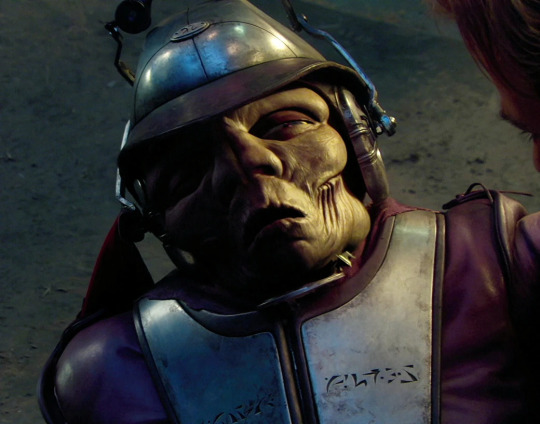
In the New Essential Guide to Weapons and Technology (2004), it explicitly states that Jango killed Zam with a Kaminoan saberdart filled with Sennari, a fast-acting neurotoxin first appearing in the West End Games RPG supplement Tatooine Manhunt (1989).
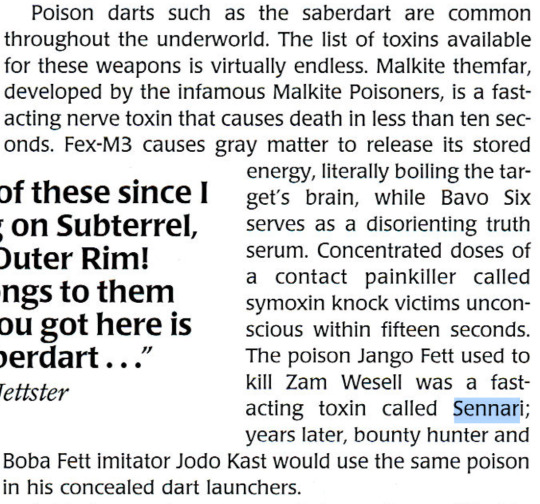
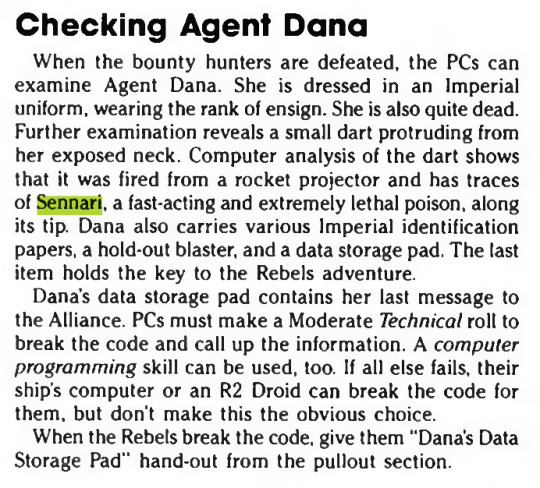
In Canon, we don't have an absolutely definite answer, but the recently released Star Wars Encyclopedia (2024), and its previous incarnations of Ultimate Star Wars (2015 and 2019 releases), states that Kaminoan saberdarts can be filled with Malkite themfar and Fex-M3 causing death in less than 10 seconds.
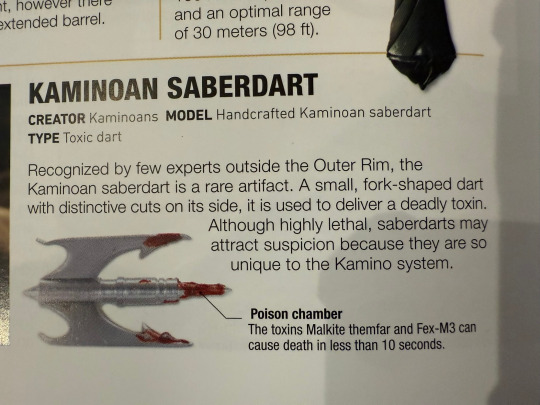
While this doesn't outright say "Jango used Malkite themfar and Fex-M3 to kill Zam", I think that it could be implied from this. However, the New Essential Guide did point out that Malkite themfar and Fex-M3 were two other poisons commonly used in saberdarts, along with Bavo Six and symoxin.
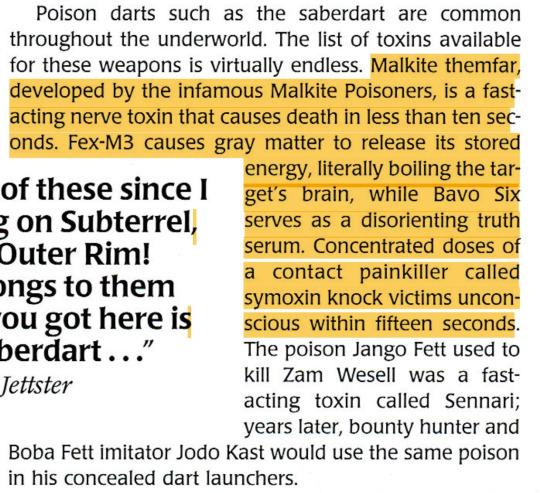
While it may have been implied with its inclusion in Star Wars Encyclopedia/Ultimate Star Wars, the only source saying what definitely killed Zam Wesell is the New Essential Guide, so I'm assuming it was in fact Sennari until it is outright stated in Canon that it was anything else.
#Zam Wesell#Jango Fett#Kaminoan saberdart#Sennari#Malkite themfar#Fex-m3#Bavo Six#symoxin#Star Wars Encyclopedia#Ultimate Star Wars#New Essential Guide to Weapons and Technology
15 notes
·
View notes
Text
Cienie's take on Mandalorian Culture: Arasuum, the God of Death, not Sloth #2
The Funeral Rites of Taungs and later Mandalorian Warriors. <> Kad Ha’rangir and Mandalorian traditional weapons (part 1 — part 2 — part 3 – part 4 – part 5) <> Arasuum, the God of Death, not Sloth (part 1 — part 2 — part 3 — part 4)
The first part was an introduction to my theory that Arasuum is not the god representing laziness, but death. I based my reasoning on the Mandalorian language that distinguishes between stagnation and laziness, as one word is not derived from another but also pointed out a visible correlation between gods names and their roles, in which laziness does not fit what the sources provided so far for Mandalorian gods. Thus laziness as Arasuum’s attribute seems to me more like modern interpretation than the original meaning behind the myth.
Establishing those two important nuances, it is time to look closely at the source material and their nature. In advance, I must warn that this part is focused on examining the sources as much as the religion itself, as text critical analysis is a natural part of widely understood research.
Keeping in that mind, let’s talk about source material.
Ancient Mandalorians were presented as religious society that once worshiped many gods before the war became a divine itself - the claim dates at least to “History of the Mandalorians” from Star Wars Insider #80, 2005. From 2005 to current day, there are three main sources that influenced fandom’s idea of Arasuum and his role in mandalorian mythology:
Mandalorian: People and Culture [Star Wars Insider #86, 2006]
Industry. Honor. Savagery: Shaping the Mandalorian Soul [The Essential Guide to Warfare, 2012]
Death Watch Manifesto [The Bounty Hunter Code, From Files of Boba Fett, 2013]
The Star Wars Insider’s article was written by Karen Traviss, whose Republic Commando book series shaped and popularized the modern Mandalorians[1]. This piece was published on February 21, 2006, which chronologically predates Republic Commando: Triple Zero, released on February 28, 2006. A lot of presented here ideas were either already part of the author's previous work (Hard Contact book and Omega: Targets short story) or will be exploited more in further novels. Understandably then, Mandalorians: People and Culture is more of an introduction to the world of Mandalorians than an ultimate guide - though a great chunk of presented in article material built the ground for writing of other authors and fans alike, it is hard to miss how it contradicts itself on some vital matters.
The article starts with the opening quote from in-universe “Mandalorians: Identity and Language”, published by the Galactic Institute of Anthropology:
In five millennia, the Mandalorians fought with and against a thousand armies on a thousand worlds. They learned to speak as many languages and absorbed weapons technology and tactics from every war. And yet, despite the overwhelming influence of alien cultures, and the absence of a true home world and even species, their own language not only survived but changed little; their way of life and their philosophy remained untouched; and their ideals and sense of family, of identity of nation, were only strengthened. Armor is not what makes a Mandalorian. Armor is simply a manifestation of an impenetrable, unassailable heart.
This passage gives us a sense of what the Mandalorians are - or rather how they are seen by the unnamed author(s). But this is a very romanticized if not outright idealized description, based more on wishful thinking than a “facts” (lore) itself.
For one, Mandalorians’ way of life did not remain untouched, as they changed from independent military force (Mandalorian Crusaders and Neo-Crusaders) into people mainly engaged in mercenary work due to lost Mandalorian Wars (3976-3960 BBY) and if we include much later New Canon, they changed from warriors to pacifist (738 BBY). Majority of Mandalorians’ inner conflicts were in fact about what Mandalorians should be, because there was no common, universal identity all people could cling to anymore. And yes, the majority of (Legends) Mandalorians saw themselves as warriors, but that was not enough to avoid schisms and civil wars.
To name the major examples, the first real friction happened just before and during the Mandalorian Wars, between traditional Crusaders and the New-Crusaders whose philosophy and purpose deviated from the universally accepted norms. Among those “oddities” was establishing color-themed armors and using them as official ranks or mass-forcing people into the Mandalorian army - something that more traditional Mandalorians like Mandalore the Ultimate or Gummig did complain about through the comics series of KotOR and spin-off sources. The Knights of the Old Republic Campaign Guide (2008) openly states that

The traditional Crusaders do not proselytize; rather, they attract others to their cause through the examples they set. Veterans see the later Neo-Crusaders movement, which actively converts outsiders in its hurry to conquer the galaxy, as a perversion.
After the war, a great number of Mandalorians became mercenaries and Canderous Ordo needed decades to rebuild the sense of warrior honor and reunite scattered Mandalorians under his banner. For his effort, he earned the name Mandalore the Preserver. And yet the discord between warriors following the old traditions and those turning into mercenaries or outright bandits preying on the weaker grew stronger. This cultural shift has never been fully merged back and so three to four centuries later, we have another ideological conflict between Mandalorians, this time those following Mandalore the Avenger (Shae Vizsla) and Heta Kol, the Field Marshal of Hidden Chain. The clash again came down to the mercenaries vs warriors/crusaders mindset that we could sum up with Heta Kol’s quote:
In Shae Vizla, I see only hypocrisy. She has driven out those who oppose her view, yet she has remade the Mandalorians into servants of anyone who pays her enough credits--no matter what they believe. Where is the honor in that?" [The Old Republic game]
Similar conflict happened decades before Clone Wars, between True Mandalorians under Jaster Mereel and later Jango Fett’s leadership and Death Watch led by Tor Vizsla. Depending on the sources, Jaster Mereel either saw Mandalorians just as highly paid soldiers (as stated in Jango Fett: Open Seasons) or brought reforms to bring Mandalorians back to the more honorable ways (as presented in majority of tie-in sources), while Tor Vizsla wished to bring back Mandalorians to their conquering galaxy roots[2].
If we include New Canon, the mandalorian conflict takes even more drastic shape, this time between exiled warriors and those who renounced their war culture for pacifism.
Which proves that in the main historic eras presented in lore, Mandalorians may share the same skills, be part of the same war culture, yet there is no “only right one” identity or philosophy that unites all people and during the inner conflicts, a great chunk of Mandalorians will consider their ideological opponents as “dar’manda”[3], or traitors regardless if they follow cultural norms or not. The Mandalorian style of life has changed and changed in a way that left their culture fractured and torn between seeking independence and rebuilding the Mandalorian Empire or accepting the life of mercenaries or even rejecting both ideologies for non violent, peaceful life.
A similar thing may be said about language, because the way people speak naturally evolves with passing time and is a reflection of their culture and historical period they lived in. For Mandalorian language to remain the same for such a large period of time - five millenia, as quote states - its speakers would need either to die out or at least live in isolation, cut off from the rest of the galaxy. Which in both cases we know is not true.
We need to remember that the post-Mandalorian Wars era is a time in which the original Mandalorians (Taungs) died out, replaced by human and non-human people adopted into culture before and during war. As then-current Mandalore the Ultimate noted himself, Mandalorians faced problems they never before had, including the new wave of recruits and not enough time to teach them their culture:

“So many new recruits. Different species, different armors, different languages - and not enough time to learn our ways”. [Knight of the Old Republic, #20]
Which is a valid reason to assume that original mando’a at some point was influenced by new recruits’ native languages, especially Basic. Because if there was no time or opportunity to teach a mass of people (often forced into the Mandalorian army against their will), then naturally all the gaps in linguistic knowledge will be filled by things “newcomers” actually knew and understood.
Going further, The Mandalorians: People and Culture provides information that:
Mando’a is predominantly a spoken language, and contractions and pronunciation variations occur much as they do among Basic speakers
and that
The infinitive ends in -ir, -ar, -ur, -or, or -er. Removing the “r” usually produces the stem, e.g.: jurir - to bear or carry. Sometimes an apostrophe separates the terminal vowel, to indicate the slight glottal stop of some Mandalorian accents. This apostrophe, known as a beten, or sigh -- as in Mando’s -- can also indicate breathing, pronunciation, or dropped letters. So ni juri kad (I carry a saber) or even ni jur’kad is a correct as ni juri kad in some communities.
or
Spelling and punctuation have optional forms so it’s hard to get it wrong. What other species might take for sloppy grammar, Mandalorians embrace as the right of the individual Mando’ad (son or daughter of Mandalore) to add their own touches to their language, much as they customize their armor.
If we agree that mando’a words can be pronounced however each Mandalorian feels like, then it is natural the language may vary from one speaker to another, and with passing time creating specific dialects for individual clans or even the whole region. For example, Concord Dawn is part of the Mandalorian Sector. The article noted
[Mandalorians] are still predominantly human, and a large percentage of the population shows genetic markers typical of the peoples of Concord Dawn and nearby planets. Although there is no true Mandalorian ethnic type, the prevalence of common gene clusters indicates that specific populations were either absorbed by the Mandalorians or joined them.
and yet, Concord Dawn, despite such historical and cultural strong ties to Mandalorians, has its own dialect[4] that is apparently still close enough to mando’a to be understand by Mandalorians however it has its own distinct words that make communication difficult.
“It wasn't Mando'a, but it was close enough for any Mandalorian to understand”. (Republic Commando: Order 66)
&
Commander Bacara was originally trained by one of the few non-Mandalorian instructors, an ex-Journeyman Protector named Cort Davin from the Concord Dawn system. [...] Bacara found it difficult to converse in Mandalorian with his brethren as he learned the peculiar dialect of Concord Dawn, which used words like “tat” instead of “vod” for “brother”. (Guide to the Grand Army of the Republic, published in Star Wars Insider: 84)
The moon of Mandalore, Concordia, apparently also has its own dialect[5], as mentioned by The Clone Wars in The Mandalore Plot episode:
Satine Kryze: He was speaking in the dialect they use on Concordia, our moon.
A dialect that the Duchess of Mandalore recognized easily and was capable of understanding and speaking it(?).
Additionally, the Complete Star Wars Encyclopedia’s entry for mando’a states:

At its core, Mando’a was a spoken language, because many different groups spoke it with enough subtle variation that writing it down became problematic [...].
As much as I agree it is impressive for Mandalorians to cultivate their culture for millenia despite many historical setbacks (including devastating military defeats) that influenced their political-economic standing in the galaxy, saying that language did not change for such a long period of time is both wrong and surprising for an in-universe academic claim officially published by the Galactic Institute of Anthropology.
I assume the author’s intent was to praise Mandalorian’s unshakable sense of identity. However, looking at it from the perspective of time and expended lore, this statement puts into question not Mandalorian history but the Republic (galactic)’s knowledge about the Mandalorians. It does not help that we have no time frame in which the in-universe academic text was written, as in how out-dated could be the source.
The main part of the Mandalorians: People and Culture is not free of inconsistency and some parts contradict each other within the same article. This is the most seen with gender norms, a topic to which we will soon come back in regard to Mandalorian religion.
At the start, the article points out unknown origin of Mandalorians
[...] they’re probably not even the original Mandalorian race. Anthropologists disagree about their roots; did they begin as humans or, as a few academics still claim, a gray-skinned non-human species? Whichever theory you find most convincing, they became a species of predominantly human nomadic warriors
while the “as a few academics still claim” statement sounds dismissive toward original Mandalorians (Taung species) and the connection between them and now predominantly human Mandalorians[6]. A connection that is confirmed in lore since at least 1995. This uncertainty of historical background acknowledged by the author puts into question further information about their religion.
Let’s take a look at the paragraph of Mandalorian religion:
Mandalorians were once intensely religious but disillusionment with the old fanaticism and worship of war itself gave way to a far less supernatural belief system among modern Mandalorians. They now regard creation tales, such as Akaanati’kar’oya (The War of Life and Death) as parables to illustrate a deeper philosophical meaning rather than literal supernaturalism. The stars were mythologized as fallen kings of Mandalore, and there are tales of the mythosaurs, but the pragmatic and skeptical Mandalorians look for allegory in these stories. The manda - best described as a combination of the collective state of being, the essence of being Mandalorian, and an oversoul - is not viewed as a literal heaven. Traditionally, the Mando afterlife is seen as a plane of spiritual energy in constant conflict between stagnation, and the opportunity for change brought about by destruction - a parallel with modern theories of cosmology. In Mandalorian myth, this conflict is symbolized by the eternal war between the sloth-god Arasuum - the personification of idle consumption and stagnation - and the vigorous destroyer god Kad Ha’rangir, who forces change and growth on the universe. Every Mando warrior who dies is said to add to the army of the afterlife, defending wives and children living in its permanent, peaceful homestead - the only place Mandalorians believe they can ever reach a non-transitory state of existence.”
The change from deeply religious society to less concerned with gods and religion feels like a natural order of things, especially when we remember that the original Mandalorians died out around four thousands years ago and their legacy was influenced by many factors since then. However, the aforementioned uncertainty of historical background for Mandalorian culture forces us to ask, to whom and which era refer to the term of traditional belief? By “traditionally” does the author here mean the already predominantly human Mandalorian culture or consider it as something passed down by “unknown” predecessors? Should we see the faith in Arassum and Kad Ha’rangir as the original religion practiced by Taung!Mandalorians or something that was created by an influx of human and other alien species that dominated the culture at some point? And it is not just a question related to Arasuum and Kad Ha’rangir, who to this day are the most prominent gods we know about but also to the concept of afterlife itself.
For one, Arasuum and Kad Ha’rangir are said to be part of the same myth, the Akaanati’kar’oya that means The War of Life and Death. Since Kad Ha’rangir is connected to growth, change and vigor it feels natural to associate him with Life, as those attributes represent the nature of living. If we agree that this god represents Life, then it is logical to assume Arasuum’s connection should be to Death, the opposed force. Arasuum name literally means stagnation and from it comes the word arasuumir - to remain the same, so this is one attribute we have no reason to question about him. However, the author calls Arasuum also the personification of idle consumption, and at first look this may sound weird, as idle or not, consumption itself is part of living. That way, both gods are tied to an aspect of Life, while the myth supposedly presents them as opposites forces, the Life and Death.
But, as the paragraph explains, Mandalorians believed that afterlife mirrors their mortal life - wives and children are living in its permanent, peaceful homestead, defended by warriors. Thus we could theorize that Arasuum’s “idle consumption” may refer to those who after death became part of “homestead” and choose(?) peace over serving in the afterlife army.
At the same time, the text presents us two separate ideas of the afterlife. One, mentioned above, mirrors mortal life. The other is a concept called MANDA, “best described as a combination of the collective state of being, the essence of being Mandalorian, and an oversoul - is not viewed as a literal heaven.” As the article stated, at some point Mandalorian people changed from a deeply religious society to one disillusioned with supernatural beliefs and that modern Mandalorians regard mythology as “parables to illustrate a deeper philosophical meaning rather than literal supernaturalism.” A change that has reflection in their funeral rites[7]. Thus we can theorize that afterlife mirroring mortal life is older than the manda itself that may be even unknown to original Mandalorians (Taungs). What brings us back to the vital questions: what era and which historical Mandalorian people fall under the “traditional” term?
This is indeed an important question, because of Mandalorians: People and Culture’s inconsistency, especially with the gender norms. For example, in paragraph MANDALORIAN SOCIETY, article claims
There is no gender in the Mandalorian language. This mirrors the equal status of men and women and the general flexibility of societal roles, despite what appears to many to be a traditional division of tasks along gender lines.
yet
Men are expected to be warriors and to raise and train their sons to be the same. Women maintain the home wherever the nomads happen to travel, and raise daughters. But women also are expected to have the combat skills of a man in order to defend the homestead when men are away. Women also fight alongside men on battlefront. If they have no dependent children to care for, they're expected to share the responsibilities of defense and warfare."
or
If the first child is a son, parents may wait eight years before having another child so that the first is old enough to accompany his father and be trained as a soldier for five years until he reaches adulthood at 13. Then his father is free to train a younger son. At 13, both girls and boys undergo a rite of passage in military and survival skills that makes them legally adults. If the firstborn is a girl, the couple may try for a son soon afterwards. A daughter will usually stay with her mother until she marries. But if a couple has only daughters, the girls will be trained as warriors by their father exactly as boys would be. Boys learn their earliest lessons from their mothers before the age of eight, so her fighting skills are critical; a couple pledges to raise warriors, and this is a joint commitment
which is far from gender equality (something mentioned by author also in her book series), as girls are treated as second-rated members of family compared to male descendants, while there is much more demanded from women than from men - to take care of children and train them nevertheless of their gender (while men should focus on sons first and foremost and may not be involved in their daughters’ training IF they already have a male descendant), maintain and protect home, be skilled a fighter with expertise in military and survival skills - even if it is boys that should be educated by both mother and father in combat, while girls may be trained just by mother and usually stay with her until marriage. A mother that is supposed to maintain the home (staying behind) while father takes sons with himself.
This statement[8] reflects traditional afterlife presented in the same article but makes little sense from the perspective of lore. Because we do in fact have a chance to see Mandalorian family dynamic during Mandalorian Wars, an era in which Taungs were still around. Knights of the Old Republic: War (2012) introduced us to Ko Sornell, a female Devaronian, who raided basilisk droid with her young son into battle

and who in general was deeply involved with ongoing military operations as warrior and comm specialist and simultaneously raising her children on frontlines


while there is no information about her husband's military position; we do see them together during mission - on one frame - standing arm to arm and that is all. As the couple together raised their children on frontlines, and Ko Sornell joined another mission instead of staying with her family in the detachment on Phaedacomm (thus being far away from the makeshift house for at least a few days)

until the comics again presents her with family (the last 5th issue),

it's logical to assume husband was the one that took care of their younger children[9] in the absence of their mother. Alternatively, children were under another clan member’s care when both parents were involved with a special mission on which they could not bring their kids.
What is even more interesting, Zayne Carrick - an outsider - upon meeting the Devaronian family pointed out that in the Devaronian culture, women stay at home with children while only males wander through galaxy.

and was assured by the Mandalorian family they indeed are fine with being nomads and raising children on the frontline.
This supports the statement of Mandalorians: People and Culture that “a couple pledges to raise warriors, and this is a joint commitment” but it undermines the division of adult responsibilities and the different treatment of children based on gender alone. Because a mother is not by default relegated to defending a homestead even though there are children under her care.
This is further backed up by Knights of the Old Republic Campaign Guide’s description of Mandalorian Crusaders
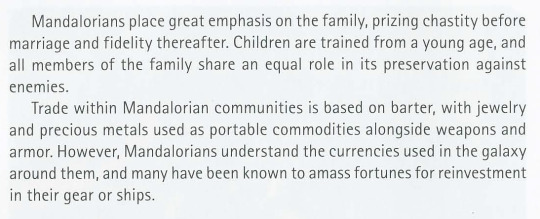
Mandalorians place great emphasis on the family, prizing chastity before marriage and fidelity thereafter. Children are trained from a young age, and all members of the family share an equal role in its preservation against enemies
and The Old Republic Encyclopedia (2012):

CLAN SOCIETY Mandalorian society operates with a minimal and largely informal power structure. Every Mandalorian is a member of a clan, either by birth or recruitment. Although different clans often disagree and even fight one another, they treat their own members like family, regardless of whether they’re related by blood ties or oath. Other than the clan chieftain, members have no official ranks or positions unless organized into a fighting unit where chain of command has a valuable place. Each man or woman is expected to contribute however they can, with those who achieve great things gaining increased respect and new responsibilities. Although clans may have ties or rivalries with other clans, there is no formal hierarchy. All chieftains report directly to the Mandalore The families of Mandalorians are close-knit and remarkably affectionate, despite the culture’s propensity for violence. Marriage is considered a lifelong commitment, and both biological and adopted children are raised with equal love. Sons and daughters are raised as warriors, as gender has little bearing in Mandalorian culture, so much their language hardly distinguishes between male and female.
If the Mandalorians in the twilight of Taung hegemony and relatively shortly after their extinction are presented as those who treat their sons and daughters as equally valued members of the community, then we should ask what caused such discord between this image and the one presented in Mandalorians: People and Culture. If we agree that the term of traditional Mandalorians from mentioned article is not about people from Sith Wars - Mandalorians Wars era and following conflicts but about those between the ancient and modern times, then once again we must determine how much the values of the original Mandalorians have been distorted through the millennia and how trustworthy is our narrator.
As the sources of widely understood lore were examined, let’s look again at the “traditional” afterlife and Mandalorian gods involved with the creation myth. As the article proclaims, “every Mando warrior who dies is said to add to the army of the afterlife”, thus we should assume it includes warriors of all genders. But then the army’s purpose is “defending wives and children living in its permanent, peaceful homestead” yet there is no information against whom the presumably non-combatant inhabitants must be defended. If said army takes part in the eternal conflict between Death and Life, an army of dead wouldn’t then serve Arasuum rather than Kad Ha’rangir, whose connection is to life and change?
There is no explanation why only wives and children are excluded, since children were meant to learn the art of war from their parents, thus logically should join their family in the ongoing battle from age of 8. We should also ask what about professions like blacksmiths or farmers who in life provided vital support for the army by making armors and weapons or producing food. Are they too enrolled into the army of the afterlife if they weren’t nomadic warriors or professional soldiers or allowed to stay in a peaceful homestead? What about those who never could become warriors due to physical or mental illness? Or the same-sex couples with their children? Article described afterlife as the “plane of spiritual energy”, but there is a gender division (women staying in safe homestead), age division (adults and children) and profession division (warriors and non-combatants/mothers/wives), wouldn’t that suggest that Mandalorians at some point believed that afterlife will to some degree mirror their mortal life? If the family bonds stay the same (marriage even in the death and children to take care of), it is not so difficult to imagine the army’s need for armor, weapons, maybe even food and clothes to continue the eternal battle.
Going further with that thought, Arasuum is the one that “remains the same”, while article adds “sloth-god, the personification of idle consumption” and the homestead located in afterlife is described as “permanent” and “peaceful” while the role of Kad Ha’rangir - the Destructor - is definitely much more aggressive in nature. I believe this could reflect the belief that life is a constant battle and struggle that every person at some point will lose, while death is the non-transitory state of existence that offers both a place of peace and an eternal army to join, thus fulfilling the religious purpose Mandalorians dedicated their life to.
Thus Kad Ha’rangir and Arasuum ties to each other may be more complex than we are led to believe because the sense of original mythology either got lost or has changed with Mandalorians over the millenia. Which is why I believe that Arasuum as sloth-god may be an effect of misinterpretation of modern Mandalorians who are disconnected from the original faith of Mandalorian!Taungs as they rejected religious fanaticism and worship of their predecessors.
It won't be an exaggeration to say that the Mandalorians: People and Culture is an important source that both helped popularize modern Mandalorians in star wars fandom during Prequels era and served as an useful introduction to their culture. However, from the perspective of widely understood lore and passing time, this article does not reflect the complexity of Mandalorian culture nor its religion. Arasuum and his opponent, Kad Ha’rangir, is only briefly introduced here but this introduction will influence other authors' take on mandalorian religion.
And those additional tie-in material will be the subject of the next part.
SIDENOTES:
[1] Karen Traviss popularized Mandalorians, however this faction was already expanded by tie-in materials in the past beyond Boba Fett’s character. Other Mandalorian human people for the first time were introduced in Star Wars 68: The Search Begins (1982), while the ancient Mandalorians (Taungs) came to life in The Sith War comics (1995), as part of Tales of the Jedi series. The game Knights of the Old Republic (2003) exploited Mandalorian Wars, and the post-war era, when Taungs died out and their legacy was passed on to the humans. Jaster Mereel’s True Mandalorians and Tor Vizsla’s Death Watch were introduced into lore in 2002, as a way to expand Jango Fett’s backstory for Attack of the Clones film, while the Death Watch name alone has been part of lore since 1989(!). Finally, the Republic Commando book series shaped and popularized the modern Mandalorians (2005-2009), before The Clone Wars animated series (2008-2020) explored the conflict between Death Watch and New Mandalorian, followed by animated TV series Rebels (2014-2018) and Disney made a whole mandalorian-focused TV series (2019-present day).
[2] It is worth keeping in mind that all information about Jaster and Tor’s ideology comes from Count Dooku’s narration. Death Watch has never stated their goals in the comics alone, while Dooku’s opinions were based on information delivered by Jaster & Jango’s allies (including Silas, True Mandalorian tortured by the Sith Lord for information about Jaster’s death). So though Jango Fett: Open Seasons with no doubt is not an objective in its narratives, it gives some credibility to Dooku’s claim about Jaster and True Mandalorians as he sought out Fett's allies in his research about Jango’s past.
[3] dar’manda means a state of not being Mandalorian - a person that is not an outsider, but one who has lost or given up on their heritage, mandalorian identity and the soul.
[4] The dialect was first presented in The Cestus Deception book (2004) as a Mandalorian language but Guide to the Grand Army of the Republic by Karen Traviss and Ryan Kaufman published in Star Wars Insider #84 (september 2005) retconned it as a separate dialect. The “mistake” made in the book is however easy to explain - Sheeka Tull knew Jango Fett personally, after he freed himself from slavery but between he went full into the bounty hunting profession. As she herself was not a Mandalorian and she and Jango met in the Meridian sector, she could mistake Jango’s native language for the mando’a. Fett, as a person born and raised on Concord Dawn could even mix his native language with mando’a. Understandably, Sheeka couldn’t see the difference if she had no other ties to mandalorian culture than one year of dating (post-Galidraan) Jango Fett.
[5] The Behind the Scenes section of wookiepedia’s page for Concordia dialect states that:
At least one Concordian phrase from "The Mandalore Plot"—specifically the line exclaimed by the Death Watch bomber before leaping to his death, and featured as this article's main quote—appears to have been drawn from a 2007 post on the Empire at War forum, in which a user had compiled a list of fanon words and translations for the fledgling Mandalorian language. The aforementioned quote, "Calhava bru'chun dralshye'ran," was translated in the post as "Compassionate leaders will burn." Although the translation would seem contextually appropriate to the episode's storyline, to date there has been no official confirmation that this is the canonically accepted translation.
[6] The part of article focused on language acknowledged the similarity between mando'a and the language of the Taung "from whom the original inhabitations of Mandalore were thought to be descended", yet still does call mando'a origins as unclear.

[7] There is a visible difference between ancient and modern Mandalorians in regard to their dead. Ancient Mandalorians took time to perform proper funeral rites for warriors killed in fight and even have special Death Ceremony for the most brave while modern people have less strict approach. Partially due to the nature of mercenary work (when sometimes the body of fallen comrade could not be brought back to home) and partially due to believing in Manda, in which soul is more important than the body.
[8] The presented idea of Mandalorian fathers training sons may in fact be based on Attack of the Clones Visual Guide (2002) and not be Karen Taviss' own invention. I think the presented informations in her article could be an attempt to keep lore intact. Below the AotC Visual Guide's description for comparison:
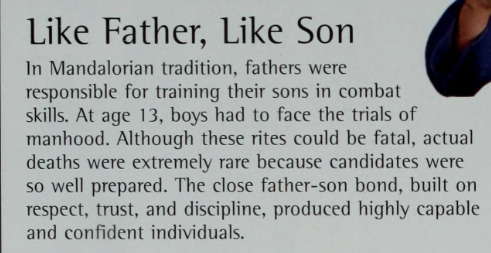
Like Father, Like Son In Mandalorian tradition, fathers were responsible for training their sons in combat skills. At age 13, boys had to face the trials of manhood. Although these rites could be fatal, actual deaths were extremely rare because candidates were so well prepared. The close father-son bond, built on respect, trust, and discipline, produced highly capable and confident individuals.
[9] The presented frame with Ko Sornell's family forgot include the small baby presented in issue #2 (the frames as reference were included in the analysis). Considering the mentioned baby and how the daughter is much smaller than the son at least in the one frame we see the kids close-up,

I think it is safe to assume there were two younger children most likely left under father's care while Ko Sornell was raiding the basilisk droid with her son (and three kids to take care of when Ko was far away for at least few days).
#star wars#cienie's take on mandalorian culture#arasuum#kad ha'rangir#mandalorian culture#mandalorian religion#I’m fully aware that Mandalorians: People and Culture (2006) predates a great number of tie-in material. that expanded our knowledge about#but it was important to establish how outdated the article is from the perspective of time.#i tend to see M:PaC as a good start into basic idea of culture but told from the perspective of modern mandalorians#while the knowledge about ancient times may be misinterpreted by “modern narrator”#also trust me to write a long post and add another wall of sidenotes lol#i know i'm pretty critical to KT's take on gender norms and some aspect of mando culture but the focus on father-son bonds#may be in fact influenced by earlier estabilished informations#but then taungs are pretty much ignored by the author when the religion definitely was affected by taungs
5 notes
·
View notes
Text
Unveiling the Ultimate Guide to Lightsabers: Your Path to Legendary Battles
Lightsabers have captivated the imaginations of Star Wars fans for generations, serving as iconic symbols of power, heroism, and adventure. Whether you're drawn to the noble path of the Jedi or tempted by the seductive allure of the Sith, finding the perfect lightsaber to embark on your own epic journey is essential. In this comprehensive guide, we'll delve into the realm of lightsabers, exploring top-tier brands, innovative technologies, and the best places to acquire these legendary weapons in the USA.

XENOPIXEL LIGHTSABERS in USA: Ignite Your Adventure
First up on our quest for the ultimate lightsaber experience is XENOPIXEL. Renowned for their craftsmanship and attention to detail, XENOPIXEL lightsabers are a testament to the dedication and passion of their creators. With a diverse range of designs and customizable options, XENOPIXEL offers something for every fan, whether you're a collector, cosplayer, or aspiring Jedi. Now available in the USA, XENOPIXEL lightsabers invite you to ignite your adventure and embrace the power of the Force like never before.
PROFFIEBOARD LIGHTSABERS: Harness the Power of Innovation
Next, we turn our attention to Proffieboard lightsabers, revered for their cutting-edge technology and unrivaled performance. Featuring advanced sound and motion sensing capabilities, Proffieboard lightsabers deliver a truly immersive combat experience, allowing you to engage in epic duels with unparalleled realism. With customizable sound fonts and blade effects, these sabers put the power of customization in your hands, enabling you to create a lightsaber that's uniquely yours.
Best Place to Buy Dueling Lightsabers: Where Quality Meets Performance
When it comes to dueling lightsabers, finding the best place to purchase is crucial. Look no further than reputable online retailers and specialty stores that prioritize quality, durability, and authenticity. From responsive blades to ergonomic hilt designs, the best dueling lightsabers are engineered to withstand the rigors of combat while providing optimal performance and control. Whether you're a seasoned duelist or just starting your journey, investing in a high-quality lightsaber from a trusted source ensures a thrilling and satisfying experience.
Best Lightsabers USA: Unleash Your Inner Warrior
In the quest for the best lightsabers in the USA, discerning enthusiasts seek out brands and manufacturers known for their commitment to excellence. From renowned franchises to independent artisans, the best lightsabers boast superior craftsmanship, attention to detail, and innovative features that set them apart from the rest. Whether you're seeking authenticity, performance, or customization options, the USA offers a diverse array of lightsabers to suit every taste and preference.
Custom Dueling Lightsabers USA: Forge Your Own Destiny
For those who crave a lightsaber as unique as they are, custom dueling lightsabers offer the ultimate expression of individuality and creativity. Collaborate with skilled artisans and craftsmen to design a lightsaber that reflects your personality, preferences, and fighting style. From hilt materials to blade colors, every aspect of your custom lightsaber can be tailored to your specifications, ensuring a one-of-a-kind weapon that's truly yours. Embrace the opportunity to forge your own destiny and wield a lightsaber that stands apart from the rest.
Custom Lightsaber Companies: Where Dreams Become Reality
Finally, we explore the world of custom lightsaber companies, where dreams of wielding a personalized lightsaber come to life. These dedicated artisans and craftsmen are passionate about their craft, blending traditional techniques with modern innovation to create works of art that transcend mere weaponry. With a focus on quality, authenticity, and customer satisfaction, custom lightsaber companies offer a bespoke experience unlike any other. Whether you're seeking a screen-accurate replica or a completely original design, these companies are committed to making your lightsaber dreams a reality.
In conclusion, the world of lightsabers is as vast and diverse as the galaxy itself, offering endless opportunities for adventure, excitement, and self-discovery. Whether you're drawn to the elegance of a XENOPIXEL lightsaber, the innovation of a Proffieboard saber, or the uniqueness of a custom creation, the journey to finding your perfect lightsaber is an exhilarating one. With the guidance of this comprehensive guide, may the Force be with you as you embark on your quest for lightsaber greatness.
#Imperial Credits#best lightsaber duels#connector piece#EXOTIC LIGHTSABERS#SN-PIXEL lightsaber#star wars lightsaber for sale
0 notes
Text
Buy Neopixel Lightsaber Online – What To Look For When Buying
In the ever-expanding universe of Star Wars, the dream of wielding a lightsaber has captivated fans for generations. With the advent of neopixel technology, lightsabers have transcended mere replicas, offering enthusiasts an immersive experience that mirrors the cinematic brilliance of the galaxy far, far away.
Embark on a journey through the online realm, exploring the possibilities and excitement of purchasing neopixel lightsaber online.
A Technological Marvel
Understanding Neopixel Technology- Neopixel lightsabers have revolutionized the lightsaber experience, offering a level of realism and customization previously unimaginable. Neopixel technology allows for individual control of each LED in the blade, resulting in vibrant and dynamic color effects, smooth motion, and realistic clash sounds.
Immersive Lightsaber Experience- The allure of neopixel lightsabers lies in their ability to replicate the iconic weapons of the Jedi and Sith with unparalleled authenticity. From the hum of the blade to the flickering glow and responsive motion sensors, when you buy neopixel lightsaber online it provides an immersive experience that transports fans into the heart of the Star Wars universe.

What to Look for When Buying Online-
Hilt Design- Consider the variety of hilt designs offered by the online seller. Whether you prefer a classic Jedi hilt or a more elaborate Sith design, the hilt should resonate with your personal style.
Blade Quality- Assess the quality of the neopixel blade. A durable and well-constructed blade is essential for a realistic lightsaber experience. Look for options that provide vibrant colors and smooth blade effects.
Sound Effects- The sound is a crucial aspect of the lightsaber experience. Check for neopixel lightsabers that offer customizable sound fonts, responsive motion sensors, and realistic clash effects to enhance the overall immersion.
As technology continues to evolve, the dream of wielding a lightsaber becomes more tangible with neopixel lightsabers. To buy neopixel lightsaber online online opens up a galaxy of possibilities for enthusiasts, allowing them to customize and own a piece of the Star Wars universe. So, whether you are a Jedi, Sith, or an adventurer exploring the vast reaches of the galaxy, may the Force guide you in finding the perfect neopixel lightsaber to ignite your Star Wars journey.
#buy neopixel lightsaber#buy lightsaber online#order lightsaber online#lightsaber price australia#order lightsaber
0 notes
Text
Israel is set to begin an imminent ground operation in an effort to destroy Hamas after the militant group’s cross-border invasion into Israel left more than 1,300 people dead this week.
Israeli officials said the goal of the effort is to dismantle Hamas—destroying its infrastructure, decapitating its leadership, and decimating its rank-and-file troops. And they’re asking civilians to get out of harm’s way. The Israeli military on Thursday ordered the evacuation of more than 1 million people from northern Gaza—a move the United Nations condemned, warning against “devastating humanitarian consequences” from the forced relocation.
But officials and experts are wary that Israel, one of the most advanced militaries in the world, with a stockpile of American precision-guided munitions at its disposal, will get drawn into an urban brawl with the Iran-backed militant group.
“They’ll seek to draw it into a city street fight,” said Frank McKenzie, a retired U.S. Marine four-star general who led U.S. Central Command, overseeing all American troops in the Middle East, until 2022. “They can use their tunnel network to get in behind the attack or to attack in all directions to make it very difficult for Israel to effectively employ a technological advantage.”
McKenzie said that Hamas will likely try to take the fight into a proverbial phone booth, up close and personal, “where it’s very hard to discern where Israeli forces end or Hamas begins.”
Hamas may also take a page from the Islamic State, which utilized tactics to blend into the dense urban environment in its dual capitals of Mosul, in Iraq, and Raqqa, in Syria, using women, children, and disabled people as human shields, before a U.S.-supported coalition helped demolish its self-declared caliphate. Haim Regev, Israel’s ambassador to the European Union and NATO, asserted in an interview that Hamas will likely use human shields to protect itself. “All options are on the table,” Regev said. “But it’s going to be very tough.”
The Israeli military insists it has protocols in place to protect the civilian population in Gaza, a thin strip of land in between Israel and Egypt that is about the geographic size of Philadelphia and is one of the most densely populated areas in the world.
“The goal is to hit Hamas in a way that it will never recover militarily,” Regev told Foreign Policy in an interview in his office on Tuesday. “We have to be sensitive. There are 2 million people there in Gaza. We are warning people before we hit some of the targets.” Regev said the Israeli military had succeeded in stopping, killing, or arresting the remaining Hamas infiltrators who had broken through the fence over the weekend.
The Israel Defense Forces (IDF), which has mobilized 300,000 reserve troops, about two-thirds of the active-duty U.S. Army, is dropping leaflets and plans to knock on doors to let residents know it is coming, when operational conditions allow it. And even if Israel follows the protocols to the letter, which include diverting airstrikes if warplanes detect the presence of children nearby, Hamas can draw on an extensive network of man-made tunnels under the Gaza Strip that it can use to store supplies of weapons and food or prepare more attacks.
“They will have to dismount their infantry and essentially fight soldier on soldier and block by block in the built-up areas,” said Mick Mulroy, a former U.S. deputy assistant secretary of defense for the Middle East. “Special operations forces may be leaping ahead in surgical strikes to take out Hamas leadership and recover hostages.”
Even as Israel prepares the urban battlefield with airstrikes while softening up Hamas targets with artillery and indirect fire, the human cost of the war continues to rise. Israel’s death toll has soared to 1,300 people since Hamas fighters breached the Gaza border fence on Saturday. The Israeli military said it has recovered the bodies of more than 1,500 militants from the group, which the United States and European Union designate as a terror organization, some of them from roadsides in southern Israel.
Regev said the Israeli military operation also aimed to stop the cycle of Hamas rocket strikes from Gaza—most of which are intercepted by Israel’s Iron Dome missile defense system—that have been a feature of life in the country for years. “The rocket era from Gaza has ended,” Regev said. “Now there is zero tolerance.” The Israeli diplomat added that the country hoped to see moderate Palestinians take control of the Gaza Strip after the operation but said that Israel did not have any intention to again control the area as it once did and would withdraw troops after the military achieved its mission.
Israeli Defense Minister Yoav Gallant on Tuesday announced Israel’s move to a full offensive following Hamas’s deadly attack from the weekend. As the Israeli military prepares for a possible ground strike in Gaza, it has already imposed a food, fuel, and water blockade. Gaza’s sole power plant ran out of fuel on Wednesday—increasing the risk of hospital generators dying and exacerbating the crisis.
Mulroy said that while the IDF had superior troops, weapons, and equipment, Hamas has become very comfortable fighting in the urban jungle on home soil. As IDF troops come forward, Mulroy said, they are likely to face obstacles aimed at directing them into prepared kill zones where mines, anti-tank missiles, and deadly drones can take out their tanks and vehicles.
“This is about as hard a tactical problem as anyone has faced lately,” said Joseph Votel, a retired U.S. Army four-star general who led U.S. Central Command until 2019.
And the threat on the northern front is even worse: Iran-backed Hezbollah boasts a missile force of between 150,000 and 180,000 rockets that it could fire into Israel if it enters the conflict in any significant fashion.
U.N. experts warn that without essential supplies, the 2.3 million Gazans are at an “inescapable risk of starvation” and are calling for an immediate de-escalation. “[T]here’s going to be a determined effort to try to decapitate Hamas,” said Michael Lynk, who served as the U.N. special rapporteur on the situation of human rights in the Palestinian territories. “And the only way to do that is to lay waste to large sections of Gaza and its civilian population.”
“This is both a humanitarian crisis and a challenge for international law,” he said. “Collective punishment, the punishment of not the guilty but the innocent, is an absolute prohibition in the Fourth Geneva Convention which governs the laws of occupation and the laws of war.”
The U.N. has estimated that at least 340,000 Palestinians have been displaced by the fighting, and there are likely to be more as the Biden administration has urged putting in place humanitarian corridors so the Israeli ground operation can proceed with as little civilian bloodshed as possible.
It’s already been a bad year. Omar Shakir, the Israel and Palestine director at Human Rights Watch, said that 2023 saw the most Palestinians killed in the West Bank in any year since the U.N. began systematically recording fatalities in 2005.
“The bloodshed did not begin this week,” he said.
1 note
·
View note
Photo
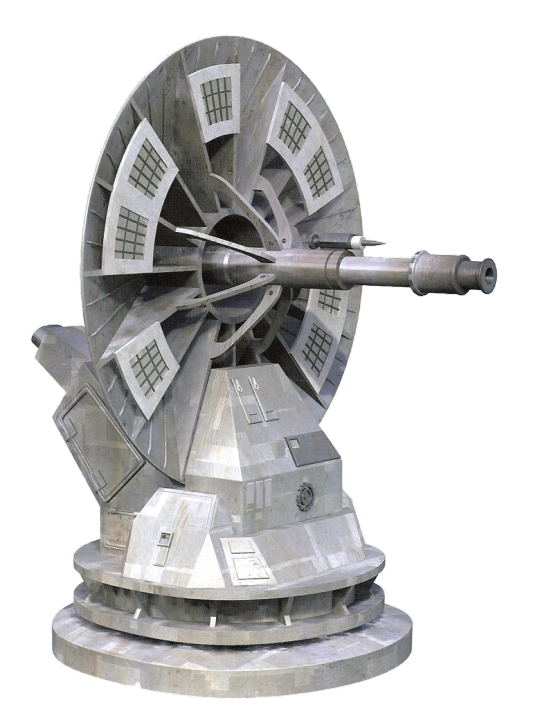
1.4 FD P-Towers were a type of stationary anti-vehicular artillery turret. Effective against small and midsize vehicles, the P-Tower fired by charging a beam that was often enough to eliminate a target in a single well-placed blast. They were cheap and able to withstand extreme heat and cold, leading the Rebellion to find use for them. Many Rebel commanders disliked P-Towers, however, due to their ineffectiveness against heavy Imperial assault vehicles.
Source: The New Essential Guide to Weapons & Technology (Art: Ian Fullwood; 2004)
First Appearance: Star Wars: The Empire Strikes Back (1980)
Read more on Wookieepedia.
#1.4 fd p-tower#star wars weapons#rebel alliance#battle of hoth#ian fullwood#star wars episode v#the empire strikes back#esb#star wars#expanded universe#star wars canon#star wars legends
11 notes
·
View notes
Text
Yes! Twilight Company mentions this at multiple points. Blasters have battery-type things called power packs, and when a power pack runs out, the blaster needs to be reloaded, much like a gun.
Do blasters in sw ever run out of juice
#sorry if this is a joke post here's a real answer#audrey#ugh. anyone would think you'd never read the star wars essential guide to weapons and technology#sw
4 notes
·
View notes
Text

Zaltin Corporation Bacta Tank
Source: The Essential Guide to Weapons and Technology (Del Rey, 1997)
#star wars#zaltin corporation#bacta tank#medical technology#fx-7#2-1b#rebel alliance#echo base#rebel alliance technology#first appearance the empire strikes back#essential guide to weapons and technology#essential guides#bacta#medical droids
115 notes
·
View notes
Text
Star Wars Alien Species - Trianii
Trian, Trianii homeworld was a planet located within the Trian system of Wild Space.
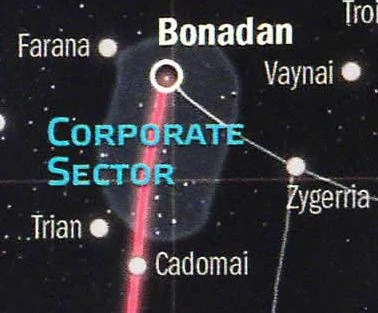
The Trianii were a fiercely independent people. They were constantly driven to explore, and being technologically advanced, they established colonies in no less than six neighboring systems, including Brochiib, Pypin, Ekibo, and Fibuli. Each of these colonies was organized as a completely independent civilization, founded by Trianii who were seeking a different way of life.
Because of their determination and forbearance, they ferociously resisted Corporate Sector Authority expansion into their territories, starting the CSA–Trianii War. Colonists assisted by the Trianii Rangers (an independent space force of the Trianii people) pushed the invaders out of their colonies.
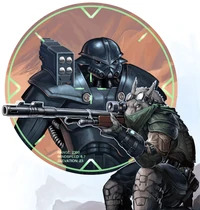
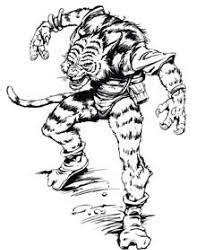
Very little is actually mentioned of the Trianii Rangers, but it is garnered that they are presumably adept combatants in space, with training also in practical warfare, something the CSA took note of when they encountered unnaturally stiff resistance from the sentients. During the skirmishes between the two, a few Trianii were captured and interrogated- some were sent to the asteroid prison facility of Stars' End, before its destruction.
Trian remained independent and unhindered throughout the rise and fall of the Galactic Empire. After the Empire fell, the Trianii indicated no desire to join the New Republic.
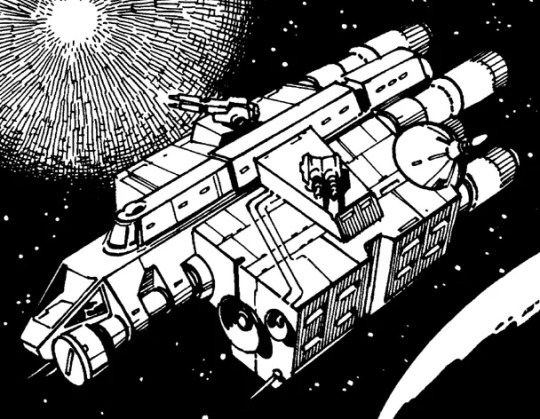
The Trianii produced a number of starship designs, such as the RX4 Patrol Ship.
Trianii culture was organized around their religious beliefs, with dance, art, music, literature, and even industry and commerce all revolving around spirituality. At one time, the Trianii had many different religions, but the leaders of these different faiths all agreed upon a specific moral code of conduct and brought together a religious coalition that lasted for thousands of years. Most Trianii were still active in the traditional faith of their families, though, and all religious figures were held in great regard.
Trianii females were generally stronger than their male counterparts, as well as being more dexterous and mindful of artistic values. For this reason, tribunals of females called yu'nar governed their society.
The Trianii usually wore no clothing, except when it was needed for utility or protection. The one common garment of the species was a belt, used to carry tools, weapons, or other items. Ceremonial garb was usually limited to jewelry, ribbons, and other such adornments.
(While the novel Han Solo at Stars' End specifically states that Trianii do not typically wear clothing, the comic adaptation of the book, as well as the entry in The Essential Guide to Alien Species, show Trianii wearing clothing. This may have been due to reluctance on the part of publishers to print what some readers might construe as nudity.)
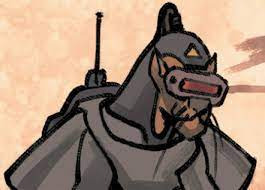

Their general form was in some ways similar to the Togorians, Cathar, and Catuman Warriors (indeed, many Trianii that were found on other worlds were mistaken for the aforementioned species), and like them, Trianii had excellent balance and eyesight, and a talent for leaping, jumping, and acrobatics. Unlike most other feline species, however, Trianii had prehensile tails. They had fur, which could come in a variety of colors and patterns.
A typical Trianii stands at 2.0 meters or 6.6 feet tall and weighs 95 kilograms or 209 pounds.
Trianii age at the following stages:
1 - 11 Child
12 - 17 Young Adult
18 - 44 Adult
45 - 64 Middle Age
65 - 84 Old
Examples of Names: Atuarre, Duarrid, Keeheen, Pakka, Reakhas, Shearran, Tuunac.
Languages: The Trianii language is composed of purrs, growls, and rolling vocalizations. The written form uses a syllabary instead of an alphabet. Trianii encountered outside Trianii space have some fluency in Basic, but few are literate in it.
9 notes
·
View notes
Text
I am reading the Rogue One visual guide and I’m going to ramble at you about it
Starting with Baze and Chirrut facts because nothing is more important than Baze and Chirrut
- The Guardians of the Whills believe very deeply in the Force but their cosmology doesn’t center any fight between light and dark and they believe mortal minds can ‘encompass the totality of the Force’ with the right training (seemingly even for non-Force sensitives). *thinks of a little green baby who’s going to need some help with his place in the universe one day and how reductive the light/dark side dichotomy can be* good to know good to know. yes everything eventually comes down to baby yoda and his poor stressed out dad. protect them
- “Opposites in balance. Chirrut Îmwe and Baze Malbus share a homeworld and a history, although they strike a compelling contrast. Baze is a hardened pragmatist, while Chirrut’s faith flourishes even in trying times. They both claim to act as the protector of the other.”
in every way they are #goals. bffs/partners to lovers is Everything. ‘They both claim to act as the protector of the other’ is very funny and very sweet and very true; my favourite thing
- this book describes chirrut as baze’s ‘best friend and moral compass’, which is a funny way of spelling ‘husband of 30 years’ but who am I to criticize
- baze is just. he’s so good. they say here pragmatism is his biggest trait but you can tell how much love has been at the center of him (and probably continues to be under it all) from the totality of his rage. I don’t think you can be this deeply hurt without loving just as deeply first. (like chirrut says, he used to believe more than anyone and now he’s thrown aside literally everything about the guardians except chirrut) it’s like he’s suffered a moral wound just seeing what’s happened to his home and it won’t heal and it never does, he just loses chirrut too and then at least it’s over. jesus christ it’s so soul crushingly sad in a quiet undramatic way
- “Though both are Guardians of the Whills, Baze and Chirrut could not be more different in their approach to combat. Traditionalist Chirrut still carries weapons associated with the ancient order, while Baze adopts an implement of modern warfare. Their methods suit them individually, and both are effective extensions of their distinctive personalities. Though Baze may chide Chirrut for his antiques, and Chirrut may decry Baze’s reliance on soulless tools, they trust each other’s defences to such weapons.”
THEY TRUST EACH OTHER’S DEFENCES TO SUCH WEAPONS. YOU HAD TO WORD IT LIKE THAT HUH. YOU HAD TO GO AND MAKE IT CLEAR THEY’RE EACH OTHER’S MOST IMPORTANT THING IN THE WHOLE WORLD. WHAT. THE FUCK
- it’s implied baze’s hair used to be shorter when he was a Guardian! he’s just let it grow past what’s customary for them (and an excellent choice too his hair is wonderful)
- his repeating blaster is described as ‘modified and highly illegal’ hahaha
it also weighs 30 kg and is meant to be mounted on a tank
baze is the best
- chirrut built his own lightbow! apparently used to be a thing the guardians did to symbolize the end of their training. I wonder if baze used to have one too? even more I wonder if they’ve always been part of the same uh ‘divisions’ or what have you within the guardians, because I think there are some implications that baze has been more of an assassin/focused on violent conflicts even before the empire came and chirrut hasn’t
- this book does not adequately capture chirrut’s trickster/funny side, making me wonder how much of that was an addition by the actor and how much was planned out
- honestly... more baze & chirrut (well baze/chirrut let’s not play here) prequel books WHEN. what does their living room look like (because we do know they live together) how did they meet, when exactly did baze lose his faith and chirrut his sight, what was their first kiss like
inquiring minds want to know (it’s me I want to know)
- unless the wording is deliberately misleading here chirrut was not born blind (though he won’t discuss how he ended up this way) and he’s learned his current fighting technique over a prolonged period of time
- bodhi is a bit of a gambling addict! and specifically one who’s pretty good at it; even after the empire knows he’s a defector he gets past their restrictions because he’s saved up all the credits/favours/even id-vouchers he’s owed by other imperial grunts fsdhfksdjf precious I love him
- saw gerrera’s medical droid a) has been modified so its programming won’t stop it from being able to dispense drugs at dangerous intervals, b) professes sheer bafflement that saw is still alive and c) is ‘frequently deactivated to prevent it from building an ethical case to discontinue treatment’. I find the whole thing darkly hilarious.
- there are literally whole subplots going on in the crowd scenes on Jedha about a mad evil surgeon who ‘decraniates’ people (essentially turning them into mindless servile husks with all of their head above the nose cut off, somehow), a masked cop from the Milvayne Authority who’s gone rogue to do the right thing and hunt him down against orders, a death cult, a bunch of different religious sects, a translation droid who has befriended a group of local orphans and shares his credits with them so they can eat and he’s SAVING UP FOR A PROCESSOR UPGRADE SO HE CAN BEGIN TO UNDERSTAND THE NATURE OF SPIRITUALITY ;_____; what the fuck I want a tv-series about this droid IMMEDIATELY
- this book shows you just how crucial K-2 is as an asset and what a masterstroke cassian’s reprogramming of him is... and it says some very, very sweet things about cassian as a person under all the trauma and spy stuff that he essentially treats him as his best friend instead of a tool. cASSIAN he deserved to survive and have SO much therapy ;_____; ah well at least we’re getting a prequel series about him right? pls be good
- oh cassian was a proper separatist during the clone wars! he probably has some very interesting points of view about the republic pre- and post empire huh (this is what I love about the clone wars era; they have built SUCH a believable and interesting political world here, all shades of grey. there were separatists with very valid points even thought they were lead by a guy named COUNT DOOKU played by CHRISTOPHER LEE, the first sign that you should look inwards and ask yourself... wait are we the bad guys)
- it’s so much more understandable to me now who in the rebel leadership is for following jyn’s plan and who is not. (namely: the ministers of finance and industry are both Not Into challenging the empire directly, kind of understandably)
in depth description of weapons technology... I sleep. deep dives into the political structure of the alliance leadership and their backgrounds and motivations? I have never been happier
(this. sort of should have been in the actual movie tho things would have made more sense)
- BAIL ORGANA Leia’s actual dad out there lookin’ fiiine, being righteous and good, almost making me forget he’s going to die SO SOON oh fuck :(
- orson krennic is, presumably straight faced, described as ‘a cruel but brilliant man’ which is PATENTLY LUDICROUS because krennic is by literally every indication a fucking idiot, he needs galen to do all the real work for him, he mouths off to DARTH VADER and then tarkin just effortlessly swoops in and fucks him over in the end, easily outmaneuvering him... orson krennic is a fucking loser I don’t care if he’s the one who introduced brutalist architecture to coruscant
lol lol lol *arrow pointing towards krennic’s head* ‘Keen mind dissects architectural puzzles and conspiratorial plots’ okay I see what happened here orson krennic wrote this book
- oh galen erso is kind of one of the most interesting and heartbreaking characters in all of star wars. (and I do not say this just because of mads mikkelsen’s cheek bones) he’s incredibly intelligent but from a really poor family and wanted to eliminate the difference between rich and poor and invent a new form of infinitely renewable energy... and technically he did achieve that, except his old college buddy orson krennic immediately found a way to use his technology for genocide and he didn’t realize until it was too late :’) there is something so comforting in the fact that in the end galen still got the last laugh in the most epic but unsung way. he’s the sort of quiet Magnificent Bastard who doesn’t even care he’ll never get the credit as long as it worked. u did good on that one jyn
also several of the scientists galen is leading on eadu are in the same category as him -- captured and forced to work for the empire. so that’s great and not at all upsetting
- galen and lyra’s falling in love story is kind of sweet (though naturally it pales against baze and chirrut’s whole deal but then who could compare) and the sheer effort and detail that’s gone into building the farmstead in the beginning we end up seeing for 5 minutes... dude (it feels very convincingly like somewhere a family would live though)
- *sees that ‘databook’ is a concept that exists apparently; groans in fic research I thought ‘holodisc’ might do the job but maybe this is a better fit*
- I will say that my largest gripe with this movie is how glaringly unnecessarily male it is. there’s literally no reason for most of the rebels and ESPECIALLY all of the scientists to be male but here we are.
well the stormtroopers could all canonically be any gender behind the armor so uh that’s. something lol
- despite being all desert-y jedha is apparently quite cool! temperature-wise I mean though the huge ancient statues lying everywhere are pretty awesome too
- wow stormtrooper armor really does just suck huh. it’s like ‘well it might protect you from a blaster bolt if you stand upwind and angle yourself just right, who knows’. I guess this is why everyone and their grandmothers are drooling over mando’s beskar lol
- star wars’ insistence on sticking to single-biome planets is so silly and I love it. stick to that incomprehensible world building decision lucasfilm I respect you
- mon mothma! basically the most important character in the star wars universe who most people won’t know about lol she’s like the anti-palps. for the most part she is one of the most Big Goods in all of star wars (along with bail) but also she’s played by the actress who voices moira in overwatch so I do instinctively distrust her whenever I hear her talk haha. called palpatine a ‘lying executioner’ to his face which is both admirably bold and remarkably restrained, considering all the things palpatine is.
- oof the two people mentioned the most on anakin/vader’s pages are palpatine and obi wan. that’s. hurtful and bad and awful. the greatest trick the devil ever pulled was making me watch ‘clone wars’ because watching ‘clone wars’ actually made me care about anakin skywalker :(
-ah shit this is a lot of pages about pasty empire dudes i’ll uh come back to these lol
#first post of 2020! keeping it on rambling brand into the new decade#star wars#rogue one#baze x chirrut#meta#if you're here for information about baze's hair and how overwatch has coloured my view of a star wars character...#boy have I got a post for you lol
30 notes
·
View notes
Text
196. Sonic the Hedgehog #128
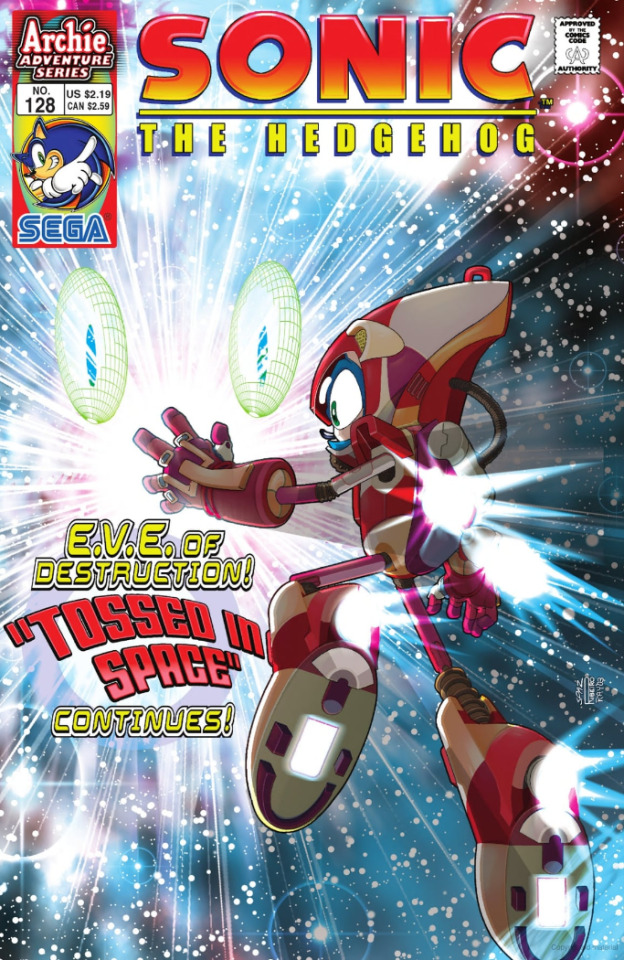
Tossed in Space (Part 4): Starmada
Writer: Benny Lee Pencils: J. Axer Colors: Jason Jensen
Sonic has set out in his new spaceship to the next destination in his journey - the highly technologically-advanced planet of Teragosa 6. However, when he gets there he finds himself in the middle of an unexpected asteroid field, with the planet nowhere in sight. He assumes he must have made a mistake, and is contacted by a group of starships which order him to dock in their flagship. When he does he's greeted by Bagbar Breeblebrox, who definitely isn't a reference to A Hitchhiker's Guide to the Galaxy or anything, and his crew, who question why he's come to this part of the galaxy.
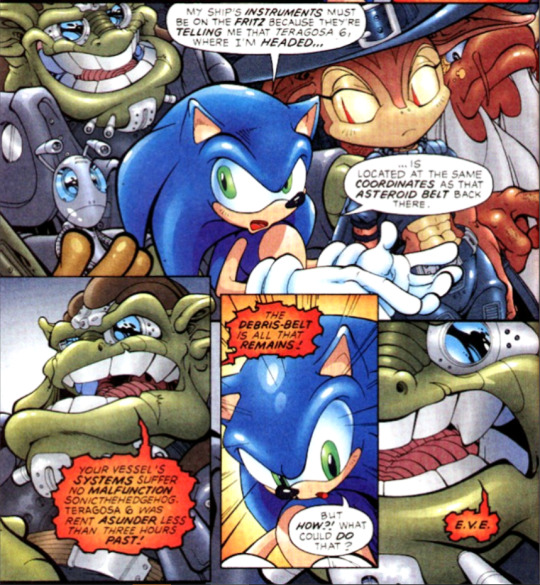
Oh, boy, remember her? She's from alllll the way back in StH#21, if you'll recall - Robotnik's "Exceptionally Versatile Evolvanoid," whom Sonic encouraged to fly out into space and seek her own destiny. Apparently, things have gone horribly wrong since then, and she's been roaming galaxies devouring high-tech worlds, incorporating them into her own mechanical shell. When Sonic mentions that he's the one who encouraged her to come out here, Bagbar, who is devoted to stopping her rampage, is outraged and orders his crew to immediately execute Sonic, who flees back to his own ship. Kinda overkill there guys, don't you think?
Tossed in Space (Part Five): E.V.E. Ill
Writer: Benny Lee Pencils: Dawn Best Colors: Jason Jensen
We've got ourselves another case of the story being inexplicably split in half here, with the only change between stories being the penciller. Sonic escapes from the Starmada and directs his ship to take him to the nearest inhabited planet to escape their attack. Meanwhile, E.V.E. has moved onto her next target… that same planet. Apparently, the inhabitants of this planet have created a perfect utopia, where technology is in total balance with nature and things like disease and war are distant memories. This is of no consequence to E.V.E., who has arrived to screw up their day for good.
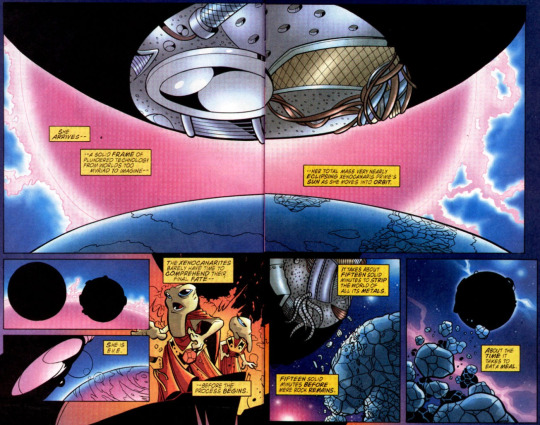
Jesus, E.V.E.! What's gotten into you? Sonic arrives a mere few minutes later, horrified to see that the planet is gone, and resolves himself to stop E.V.E. no matter what, seeing all this as his fault since he's the one who got her to leave Mobius in the first place. He and Bagbar's fleet find her at around the same moment, and Bagbar abandons his chase after Sonic to focus on firing at E.V.E. However, his fleet's weapons are woefully ineffective, and E.V.E. responds with a tractor beam that destroys the entire fleet, ripping every ship apart into tiny pieces. Man, this just gets worse and worse. Sonic, horrified, decides to pull a suicide run by ramming his ship into E.V.E.'s metal plating, but surprisingly his ship punches through without much effort, and he suits up to go outside and explore the interior of her machinery, hoping to find a way to stop her from the inside.
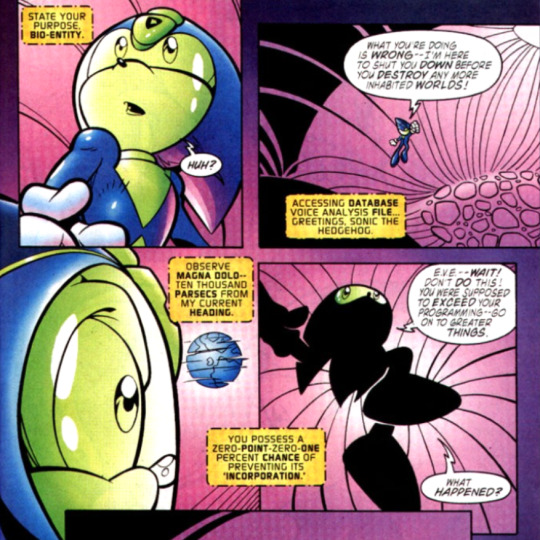
Instead of responding, E.V.E. just goes silent, and then suddenly Sally in a spacesuit of her own floats up to Sonic! He's delighted to see her again, and they share a helmet bump (because, you know, no kissing in helmets) before Sally informs him that she got here through a wormhole. They can use it to get back to Mobius, but the timeframe is short to get back to it before it closes forever.
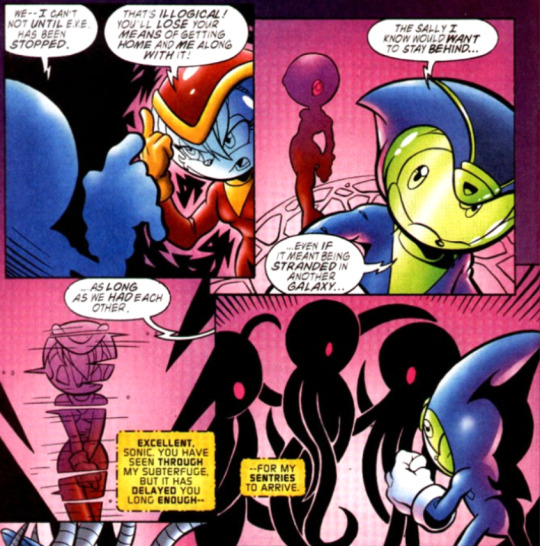
Sonic, disgusted with E.V.E.'s attempt at emotional manipulation, defeats the sentries and runs away, finding himself at the core of E.V.E.'s construct. E.V.E. herself sits in the middle of it, having gotten quite an upgrade since we last saw her - now instead of being a terrifying tentacle alien with disco balls for eyes, she's a beautiful, if still somewhat alien-looking, mechanical being, though still containing some residual tentacles. She explains her actions, how when she first tried to join the intergalactic community, she found herself hated and feared by all, ostensibly due to her appearance. Instead of just, y'know, trying to change her appearance to be less horrifying, she decided that all organic lifeforms were universally terrible, and began a campaign of genocide, which isn't an overreaction to being called ugly at all!
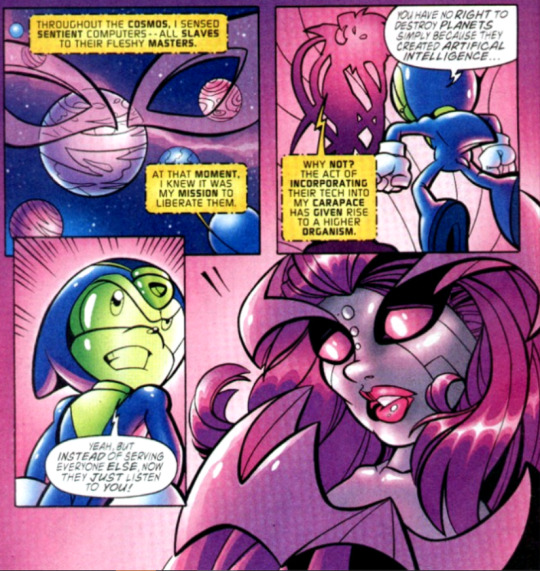
E.V.E. is totally stumped by this line of logic, and concedes that Sonic is right and she's become a monster. She informs him that to get home, he will need to go to the Bem homeworld of Argentium, also known as Wheelworld. She then changes her heading to dive into the nearest star, essentially committing suicide to atone for her actions. I think this is legit the first time we've ever seen someone actually kill themselves in this comic - we've certainly come a long way from the puns and slapstick that characterized the tone of the comic when E.V.E. was first introduced, huh? Sonic escapes from her shell in time in his damaged spaceship, and sets course for Argentium…
#nala reads archie sonic preboot#archie sonic#archie sonic preboot#sonic the hedgehog#sth 128#writer: benny lee#pencils: jeff axer#pencils: dawn best#colors: jason jensen
5 notes
·
View notes
Text
"Unveiling Excellence: A Guide to the Best Dueling Lightsabers for Ultimate Combat"
In the galaxy of lightsabers, finding the perfect weapon for dueling is an art that combines craftsmanship, technology, and the spirit of the force. Whether you're a seasoned duelist, a collector, or a Star Wars enthusiast, the quest for the best dueling lightsaber is a journey worth undertaking.

The Pinnacle of Combat: Best Dueling Lightsabers When it comes to dueling lightsabers, precision, durability, and a touch of personal flair are essential. The market boasts an array of options, but some stand out as true champions. The best dueling lightsabers combine advanced technology with superior craftsmanship, offering duelists an edge in every battle.
Craftsmanship and Design: Defining the Best Lightsabers The journey begins with understanding the elements that make a lightsaber exceptional for dueling. The hilt's construction, materials used, and ergonomic design play crucial roles in determining the overall effectiveness of a lightsaber in combat.
Leading brands, known for their commitment to quality, offer duelists a range of options. From sleek and minimalist designs to ornate and detailed hilts, the best dueling lightsabers cater to diverse preferences. Each hilt is crafted with precision, ensuring a comfortable grip and optimal control during intense duels.
Technology that Elevates: Best Lightsabers for Dueling Enter the realm of advanced technology with lightsabers that feature responsive sound systems, realistic blade effects, and precise motion detection. The best dueling lightsabers incorporate innovative components like Proffieboard, providing users with customizable settings, smooth swings, and lifelike clash sounds.
These technological advancements not only enhance the visual and auditory experience but also contribute to the overall functionality of the lightsaber in dueling scenarios. The force is truly with those who wield lightsabers equipped with cutting-edge technology.
Where to Find the Best: Buy Lightsabers Online For those eager to join the ranks of lightsaber duelists, the online realm offers a gateway to acquiring the best lightsabers. Numerous reputable vendors provide a diverse selection, ensuring enthusiasts can find the perfect lightsaber to suit their dueling style.
When looking to buy a lightsaber online, consider the vendor's reputation, customer reviews, and the range of customization options available. Trusted websites often provide detailed product descriptions, allowing buyers to make informed decisions.
Tailored for Battle: Best Lightsabers for Dueling The best lightsabers for dueling are specifically designed to withstand the rigors of combat. Duelists engage in fast-paced and intense battles, making durability a paramount consideration. Lightsabers constructed with high-quality materials such as aircraft-grade aluminum ensure longevity and resilience.
Additionally, the blade plays a crucial role in determining a lightsaber's suitability for dueling. Polycarbonate blades, known for their strength and flexibility, are favored by duelists for their ability to withstand repeated clashes without breaking.
Curated Choices: Best Lightsabers for Dueling Enthusiasts For those seeking guidance in the vast galaxy of lightsabers, a curated selection of the best lightsabers for dueling can streamline the decision-making process. From classic designs inspired by iconic characters to innovative models that push the boundaries of lightsaber aesthetics, enthusiasts can explore options that align with their combat preferences.
Conclusion: Choosing the Weapon of a Jedi or Sith In the pursuit of the best dueling lightsaber, one embarks on a journey to find not just a weapon but an extension of oneself. Whether you're drawn to the elegant precision of a Jedi or the fierce power of a Sith, the right lightsaber awaits.
To buy a lightsaber is to invest in more than a collectible; it's an invitation to partake in the timeless tradition of lightsaber dueling. Choose wisely, and may the force be with you on your path to mastering the art of combat with the best dueling lightsaber in hand.
#best place to buy dueling lightsabers usa#lightsaber connector piece#EXOTIC LIGHTSABERS ONLINE#buy lightsaber#best lightsabers for dueling#dueling lightsaber online#PROFFIEBOARD LIGHTSABERS#cheap anakin skywalker lightsaber#XENOPIXEL LIGHTSABERS#best website to buy lightsaber#LIGHTSABER DISPLAY STAND
0 notes
Text
HEY, LET ME YELL ABOUT SOME STAR WARS SHIPS. THE FLYING KIND THIS TIME. One of the banes of my existences is loving the worldbuilding of a particular canon, but not having it laid out for me in a way that’s organized for me to easily find what I’m looking for at any given moment. And flipping through (the sadly no longer canon, but still incredibly useful!) Star Wars: The Clone Wars: Incredible Vehicles (see here for info!) really helped me get my head around a lot of it and finally able to organize these pages into a more “easy to find what kind of vehicle you need for a specific type of scene” list! But what I really wanted was to see a canon reference guide organized into size/use sections, to better reference when I needed either a massive star ship or when I needed to know the name of a speeder a given character might use. (This focuses on the Clone Wars era, but if you want Empire/Rebellion era or First Order era info, feel free to give me a yell.) Encyclopedia of Starfighters and Other Vehicles: MASSIVE SHIPS: ➞ Republic Attack Cruiser - “The war between the Republic and the Separatists leads to a demandfor larger and more powerful battleships. The Republic Navy expands to include the Reupblic attack cruisers, massive warships often referred to as "Star Destroyers". (Venator-class Star Destroyers can carry more than 420 starfighters (including V-wings, X-95 Headhunters, and Jedi starfighters); 40 LAAT/i gunships; and 24 AT-ETs.)" ➞ Acclamator-class Assault Ship (Transgalactic Military Transport Ship) - "These assault ships are a predecessor of the later Star Destroyers. They are built for the Clone Wars, under false orders supposedly issued by the Jedi Council. This is all part of Darth Sidious's evil plan to take over the galaxy. (During the Clone Wars, Acclamator-class ships are stationed at Coruscant, ready to carry clone troopers across the galaxy.)(Unlike many craft of this size, Acclamator-class assault ships can land on planets, where they deploy Republic forces in an effort to retake the worlds from Separatist control.)(Each Acclamator-class assault ship requires a crew of 700 and can carry up to 16,000 clone troopers.)" ➞ Malevolence (Subjugator-class Heavy Cruiser) - During the Clone Wars, General Greivious's huge flagship leaves death and devastation in its wake. Its massive ion cannons disrupt the control systems of surrounding ships, disabling their energy weapons and deflector shields. (Four times longer than a Venator-class Star Destroyer, the Malevolence has an internal shuttle train system to deploy supplies and troops and is crewed by 900 battle droids.)" ➞ AA-9 Coruscant Freighter - "The AA-9 Coruscant Freighters are originally built to haul cargo. During the war with the Separatists, the Refugee Relief Movement has them transformed into vessels that can help people in need. The freighters transport [up to 30,000] refugees from planets that have fallen under enemy control." ➞ Pelta-class Frigate (Republic Medical Frigate) - "During the Clone Wars, the Pelta-class frigate is a common sight at the edges of space battles. It is used by the Republic Navy to treat injured clone soldiers. The more honorable generals in the Separatist fleet usually don't attack it.) Each Pelta-class frigate can carry up to 900 crew, and is equipped with 16 escape pods. Phoenix Home is modified to include turbo laser batteries.)” ➞ Invisible Hand (Providence-class Dreadnought) - “Commanded by General Grievous, the Invisible Hand plays a key role in the last great battle of the Clone Wars. With the sinister Sith Lord Count Dooku holding Chancellor Palpatine prisoner aboard the failing ship, the Jedi Order must rush to the rescue. (The Invisible Hand is a difficult ship to attack. There are 20 squadrons of droid starfighters ready to defend it. Count Dooku turns the ship upper sensor tower into his lair, calling it the "Wizard's Tower".)(The Invisible Hand is controlled with a droid brain. This means that Anakin Skywalker can override controls and fly the ship. It's still a bumpy landing!)" ➞ Coronet (Personal Spaceliner) - “The Coronet is Duchess Satine Kryze of Mandalore's personal luxury spaceliner. This one-of-a-kind ship is practically a spacefaring palace. It serves as a testament to the engineering and wealth of the Mandalorians. (The lower decks of the Coronet are used for cargo transport. The ship requires a crew of 75, and has eight engines all working in unison.)" STARFIGHTERS: ➞ V-Wing - "Small, fast, and agile, the V-wing starfighter is used late in the Clone Wars by the Republic. With ltitle in the way of firepower or armor, V-wing pilots use swarm strategies to overwhelm their opponents, assisted by an astromech droid." ➞ V-19 Torrent Starfighter - "The V-19 is used during the early days of the Clone Wars. It becomes a popular fighter for the rapidly expanding Republic Navy. Originally designed to be a short-range fighter, the V-19 later underdoes a series of upgrades that make it suitable for much longer flights." ➞ ARC-170 Starfighter - "This three-person starfighter is durable and reliable. It carries a formidable arsenal, as well as sufficient supplies for five days. It should come as no surprise that the ARC-170s rapidly replace the V-19s as the Republic's primary dogfighter during the Clone Wars. (The ARC-170s are so dependable that both the Empire and rebel forces continue to use the starfighters after the Clone Wars. They become the template for the first generation of X-wings.)" ➞ Y-Wing - "Designed for bombing raids, the Y-wing is a sleek ship originally used by the Galactic Republic. Y-wings find new life as starfighters for the Rebel Alliance during the Galactic Civil War. Stripped of every non-essential system and endlessly repaired by rebel mechanics, they remain popular with Alliance pilots. (The first Y-wings used in the Clone Wars have a gunner's station above the cockpit. In later models, one operator serves as pilote and gunner.)" ➞ ETA-2 Light Interceptor (Jedi Starfighter) - The ETA-2 Interceptor's popularity with the Jedi Order earns it the nickname the Jedi Starfighter. It is one of the fastest and most responsive starships produced during the Clone Wars. Almost every Jedi flies one, customizing the craft to meet their unique skills and requirements. (The Jedi starfighter uses heavy weaponry, but the power drain prevents constant firing. Most Jedi remove the sensors and targeting equiment to save weight and space.)" ➞ Delta-7 Light Interceptor (Specialized Jedi Starfighter) - The Delta-7 is designed specifically for the Jedi and is in frequen use long before the Clone Wars beigin. As more Jedi leave the temples to join the war effort, their combat ships are swiftly upgraded to keep pace with the enemy's crafts. This prompts the creation of the Delta-7B. (There are small improvements from the Delta-7 to the 7B. The Delta-7 has a wing part for an astromech, while the 7B places the port in front of the cockpit. The Delta-7B also boasts a tougher central hull that its predecessor.)" ➞ Naboo Starfighter (N-1 Starfighter) - Bold and beautiful in its design, the N-1 starfighter is the signature ship of the Royal Naboo Security Forces. Its forward section is clad in chromium for ceremonial display, and its sleek shape is as much an expression of art as aerodynamics. (The Naboo starfighter's long tail acts as a power charge collector. The similarly shaped engine tails serve as heat sinks.)" ➞ Republic Frigate (Consular-class Cruiser) - "Used by the Jedi and the Galactic Senate on diplomatic missions before the Clone Wars, these cruisers are retrofitted as combat frigates when war breaks out. Their upgrades include armored hull plating and laser cannon batteries. (Republic cruisers that have undergone the Charger c70 retrofit for use in the Clone Wars are longer than those that have not.)" AIRCRAFT (SPACE): ➞ Stealth Ship (Corvette with a Cloak) - "The Republic's stealth ship is able to turn invisible. It is designed with an experimental cloaking device, which allows it to sneak past Separatist blockades. As well as being impossible to see when cloaked, it is undetectable by scanners and sensors. (The stealth ship cannot fire its laser cannons or proton torpedos while cloaked, but it can launch flares to confuse enemy tracking torpedoes.)" ➞ Republic Tugboat - Republic Tubgoats are used during the Clone Wars to maneuver massive warships into docking ports at space stations. These tugboats are low on shields and have no weapons but are equipped with powerful engines and tractor beams." ➞ Turtle Tanker - "Originally designed to haul minerals from asteroid mines, the bulk tankers (commonly known as "Turtle Tankers") are cheap and easy to build. This makes them a familiar sight in established space lanes. However, their lack of weaponry makes them a rare choice outside of heavily trafficked areas." ➞ T-6 Shuttle (Jedi Ambassador Shuttle) - "This innovative shuttle design has a lasting impact on starship technology. It is built by the insectoid Verpine, and features rotating wings that allows the rest of the ship an exception degree of motion. Members of the Jedi Order use the shuttles frequently." ➞ Eta-Class Shuttle (Ambassadorial Transport) - These comfy shuttles are first used by the Galactic Senate for diplomatic missions. Later on, they are regularly employed by the Jedi in the Clone Wars. Robust and suited to long-range travel, an Eta-class shuttle is chosen for a mission in Wild Space beyond the Outer Rim. (An Eta-class shuttle comfortably seats ten passengers and two pilots. There is also room for emergency transport, such as two Undicar-class jumpseeders.)" ➞ Twilight (Corellian G9 Rigger Freighter) - The Twilight is originally the property of crime lord Ziro Desilijic Tiure. It is later claimed by Anakin Skywalker, who puts it to use during the Clone Wars. This old ship is conidered massively out of date, so Anakin spends a large amount of his free time upgrading the vehicle. (The side of the Twilight is decorated with a cartoonish painting of young Anakin's podracing. The ship's upgraded weapons system causes random color shifts in the lasers.)" ➞ Crucible (Paladin-class Corvette) - "Custom-built for the Jedi in the time of the Old Republic, the Crucible has been in service for quite some time. It is used in the training of Jedi younglings, who learn how to contstruct their own lightsabers from crystals while aboard." ➞ H-Type Nubian Yacht (Shimmering Senator's Ship) - "This yacht is the personal transport of Senator Padme Amidala. It is a luxury ship, designed for comfort rarthe than combat, but does have very powerful shielding in case of an attack. The vehicle is coated in royal chromium, reflecting its owner's high status." ➞ Naboo Royal Cruiser (Custom-build J-type Diplomatic Barge) - The invasion of Naboo convinces the peaceful planet to upgrate its diplomatic vessels. Though it still travels without weapons, this barge is far faster and better shielded than the J-type Nubian starship that came before it. It also boats a range of backup systems in case of malfunctions or sabotage. (The J-type diplomatic barge has spacious interiors designed for comfort. It has room for four prestigious passengers as well as up to five crew and six guards.)" ➞ Naboo Royal Starship (Modified J-Type 327) - This sleek ship is crafted to be a visual representation of the glory of Naboo. It has no weapons, but it is shielded in case of attack. It also has multiple astromech units, each one capable of making emergency repairs. (This ship is exclusive to the royal family of Naboo. It includes quarters for the Queen and her handmaidens, equipped with climate-controlled wardrobes.)" ➞ Naboo Star Skiff (J-type Star Skiff) - “Weapons on a Naboo royal ship are unheard of until this vessel is manufactured. It also has a duller, more practical finish compared to traditional gleaming Naboo ships. Unfortunately, the Naboo have had to adapt their ship designs for the harsh realities of battle during the Clone Wars. (The J-type star skiff is designed and built for Queen Apailana, the monarch of Naboo, in the latter days of the Clone Wars. However, the ship is also made available for Senator Padme Amidala, the former queen.)" AIRCRAFT (PLANETSIDE): ➞ LAAT (Low Altitude Assault Transport) - "The dependable LAAT is one of the Republic's main deployment craft. Heavily armrored and highly maneuverable, this war transport is often sent into combat under fire. It can glide through a storm of lasers to safely land its cargo and troops." ➞ Republic Attack Shuttle - With heavier armor and shielding than most atmosphere vessels, the Republic attack shuttle is a long-range alternative to the LAAT gunship. It is replaced by other shuttle designs after the Clone Wars, but one remains in service of the rebel Cham Syndulla during the time of Empire. (The Republic attack shuttle has a tractor beam, which is usual for a transport. It also has magnetic clamps on its underside to clasp cargo and other smaller vessels. A variant Nu-class transport has an enclosed cargo bay built in between the wings.)"
GROUNDCRAFT: ➞ Clone Turbo Tank - "This 10 wheeled tank can deliver as many as 300 clone troopers into the heart of the battle in one trip. It is designed to roll over any terraing with ease and to absorb enemy fire with no loss of function. After proving effect in the Clone Wars, the tank stays in use during the age of Empire." ➞ AT-RT - "Fast, nimble, and powerful, AT-RTs are used furing the brutal land battles of the Clone Wars. A single clone trooper will usually pilot these as a scout, ranging ahead of the battlefront and gathering intel for the main force." ➞ Stun Tank - "This Republic tank is primarily an anti-aircraft weapon. It's ion cannon drains energy from the ship it targets, leaving them helpless. Despite being designed for use against droid vehicles, the tank sees little use during the Clone Wars." ➞ AT-OT (All Terrain Open Transport) - "The imposing AT-OT has an open-top design, leaving it vulnerable to attack from above. Their role during the Clone Wars is to quickly move troops, rather than engage in battle." ➞ AT-TE (All Terrain Tactical Enforcer) - "The AT-TE looks more ilke a huge robotic insect than a military transport. It is used during the Clone Wars to move large numbers of troops through battle, and to operate as a mobile command center." ➞ SPHA-T (Self-propelled Heavy Artillery Turbolaser) - "Bearing one of the bigger ground guns used by the Republic Army, this 12-legged walker is a low but steady feature throughout the Clone Wars. Its turbolaser can destroy a starship, but can only operate for a limited time. This is because each blast uses up a vast amount of energy." WATERCRAFT: ➞ Naboo Water Speeder - "The serene lakes of Naboo are the planet's most famous sight, renowned across the galaxy for their peaceful vistas. In their free time, the Naboo take luxurious pleasure speeders out onto the water, exploring the hidden coves and majestic waterfalls. (The D-11 is manufactured by the same company as the N-1 starfighter and the two craft share many design features, despite being built to operate in very different environments.) (The D-11 water speeders were build specially for the use of the queen and the royal household. A selection of the royal boathouse is set aside for their recharging and maintenance, however Padme Amidala is less indulgent than some previous queens, and the D-11s are seldom used.)" ➞ Tribubble Bongo (Gungan Bongo Submarine) - These semi-organic subarmines have hulls that are grown rather than built, so no two are exactly alike. The Gungans equip them with hydrostatic bubble shields to keep the air in and the water out, and use them to explore the oceans of their home planet, Naboo." SPEEDERS: ➞ Barc Speeder - "This powerful speeder bike is designed for use by ARC (Advanced Recon Commando) troopers, but goes on to be piloted by other Republic fighters during the Clone Wars. Ideal for scouting missions, it is also used by police patrols on Coruscant." ➞ Jedi Turbo Speeder (Praxis Mk. 1 Turbo Speeder) - "An elegantly designed turbo speeder, the Praxis Mk. 1 is piloted by members of the Jedi Order when traveling around the city planet of Coruscant. Its thing, wedge-like design cuts down on wind resistance, and the navigation systems are programmed to bypass heavy traffic. (The Praxix Mk. 1 turbo speeder is equipped with collision-detection systems to help its pilot avoid accidents. Twin repulsor generators allow the ship to run upside-down in midair.)" PUBLIC & PERSONAL TRANSPORT: ➞ CSS-1 Corellian Star Shuttle - “"Built for diplomacy rather than battle, the CSS-1 shuttle has an impressive meeting room and comfortable quarters for VIP guests. It can carry up to 200 passengers, as well as enough supplies to last for three years. It is also equipped with an unusually strong deflector shield. (Shortly after his appointment to Supreme Chancellor of the Republic, Sheev Palpatine ant he Jedi Council travel together to Naboo aboard the CSS-1 name the Perpetuus.)” ➞ Taylander Shuttle - The Taylandor Shuttles are civilian transport vehicles during the final years of the Republic. They are a common sight amongst the peaceful Core Worlds, but are even found in the far reaches of the Outer Rim." ➞ H-2 Executive Shuttle - "The senators and even Chancellor Palpatine are among the high-profile users of this luxurious ship. Palpatine's model is docked to allow direct access from his chambers in the Senate Office Building on Coruscant. It makes for a comfy escape craft if the building is attacked." ➞ Theta-Class T-2C Shuttle - “These ships are built by Cygnus Spaceworks, under special order by Supreme Chancellor Palpatine. They have never been available for purchase. The model is eventually incorporated into the Imperial fleet, but only for the highest-ranking officers." ➞ Luxury Yacht (Personal Luxury Yacht 3000) - "In the time of the Republic, diplomats use luxury yachts for meetings and travel. They become less popular during the chaos of the Clone Wars, when they are seen as easy targets for pirates and Separatists. (Luxury yachts are common vehicles in wealthier systems. Built for comfort, they include a grand observation deck and a swimming pool, as well as five personal cabins for crew and guests.)"
557 notes
·
View notes
Note
Heyo! So I'm like suuuuuuuuper lost on like all of your WoW posts lol. Would you mind giving me a basic run down of your characters pretty please?
hey! of course! i’ll be honest, i’m still making and fleshing out a lot of the character, but this is a pretty quick and basic run-down of what I've got so far! thank you for the lovely ask!
this is missing a few of the characters that aren’t super fleshed out yet, and yes, this is my largest cast out of the CHP series!
_-_-_
Wings of War is set during the early 1970′s, in an alternate history that allows for some advanced technology, the inclusion of Intent, and the addition of wings being a natural part of some human’s forms.
it follows four teams (fluctuating numbers between five and eight members at various points) who have been hired by the Guiding Star Corporation. their job is to “develop advancements in technology, human endurance, and product testing” which, as it turns out, means that they fight to the death in endless matches, brought back to life using what’s known as a Respawn Machine.
the teams (north, south, east, and west) are shipped between ten different bases, scattered across several different countries. this represents the ability to pick different maps in most fighting, pvp, or 1st person shooter games.
on each teams, there are specific roles that the GSC are looking to have filled. each team has a “building” class, for example, which creates the titles of Builder, Maker, Techie, and Engineer. the “sneak” class consists of Assassin, Spy, Rouge, and Thief. each class can only be filled by someone with a specific set of traits, which results in, essentially, total reliance on GSC.
two teams have wings, and two teams don’t. i’m still working on filling out all the roles and creating all the characters, but here’s a basic run-down of what I have so far!
_-_-_
Adele Adler - the handler, the woman in charge. She runs relay between all four teams, doling out missions, handling issues that arrive on and off base, and acting as go between for the Teams and the Council. she’s supposed to keep her distance between them, and had managed that for all the teams before now, but...the men are growing on her! she has a surprising soft spot for most of them, and finds herself more and more willing to turn blind eyes on their shenanigans.
-
Jeremy - West Team’s “fast class”, this boy is a Speedster through and through. he has a short temper, a severe anger problem, and briefly made a living running drugs out in Boston. his weapon of choice is a chunk of wood with some sharp nails in it, and he can hit harder than you would think. runs his mouth a lot but is the only person on his team with any ability to understand the words take care of yourself.
Joshua - West Team’s Sharpshooter, and originally from New Zealand. lives in a camper just inside of the perimeters of the base. anti-social and with no interest in changing that, he took on the job because there’s a very large bounty on his head that Adele promised to get rid of.
Feliciano - the Rouge of the West team, he tries very hard to make himself look proper and put together but usually fails. had a bad reputation going when he first started, because he was pretty sick and just Not Feeling Socializing, but it’s easy enough to see that he’s a good guy these days. a former bodyguard.
Lucas - the Techie, and originally from Sao Paulo. he loves sugar sweet coffee, and has a prosthetic leg that’s fueled by Intent and a rare mineral. a technical engineer, meaning he uses Intent to make new technological advances. can talk for hours if you hit a subject that he likes.
Deiter - the Doctor of West team. he’s a good man, though he tends to have extremely manic episodes that are not helped by the incredible amount of upper’s he can often be seen taking. lost everything when the city he lived in was blown up during WW2. fiercely protective of his team-mates.
James - known as the General of the team. fought in WW2. suffered a severe head injury that still affects him today. a kind man with a lot of personality, and a love for animals. if you tell him something, he will likely forget it. don’t hold it against him, because he’s already doing that himself.
-
Tony - the Runner and local loudmouth of North team. you cannot pay this boy to be quiet, and he’s both stupid as a bag of bricks and also incredibly intelligent. from New York, where he had a lovely stint robbing the Italian mafia blind with his husband, Rizzo, until they were both shot up and picked up by Adele.
Rizzo - the Demolitions Expert of North team, and actually pretty adorable if you can get past the fact that he’s incredibly crass and has no filter between mind and mouth. Hopelessly in love with his husband, even if no one else realizes they’re married. he will burn water if you let him cook, so maybe best if you don’t.
Werner - the North team’s Medic. he’s absolutely batshit, but has a good heart. was running a black market ring in the country side when Adele found him, though he was originally from Oslo. couldn’t speak anything but German and Norwegian before coming to work for the GSC. has two pet rats.
Francois - served as a spy in WW2, and currently the North team’s Assassin. has a HEART based injury with a lot of the same symptoms as tuberculosis. was picked up by the GSC with an offer of as-of-unheard of medication. sardonic, and prone to cracking jokes that most of his team don’t pick up on.
Loto - the Archer, and a member of North team. from the Louisiana bayous, and great with a cross bow. has an old coonhound that sleeps in bed with him, but who Loto claims to hate. often forgets that he needs to actually go to the kitchen and get food, and that the food he needs is easily available.
Braeburn - the Mechanic, and the longest running member of any of the active teams. has a prosthetic arm. really fond of sweet tea, and more idea of what’s going on than he’s willing to let on. bound up in so many contracts, it’s literally woven into his Intent.
-
Elias - the OG title, Soldier, and a member of South team. fought in WW2, where he briefly met Francois before being shipped to Poland. was discharged after being severely injured, and lived homeless on the streets for a while with BJ. originally from Canada but ended up in America during his discharge due to an error on his papers. suffers from brain tumors caused by extended exposure to Iradium in the war.
BJ - the Hurricane (class title will change, I just needed a placer, oops) of South team. left an abusive home at fifteen and has been on the streets since. took a contract with GSC to get Elias medical treatment. dyslexic, and often described by his team as “being a lot”. uses a steel pipe for his preferred weapon. loves talking and telling stories.
Olek - the Firepower of the team, literally. can probably punch you hard enough to get a KO, but fights with an Iradium powered flare-gun that does serious damage. from Russia, with a strict I won’t tell you anything about my past policy, and a bizarre fondness for bears. great at giving hugs when you’re down.
Jakob - the Maker of the team. has a highly advanced prosthetic eye. losing the vision in his other eye. the guy who picked up BJ and Elias. has a real morality struggle between the job he does, and his own views on Mercy. probably needs a hug more than he lets on.
-
Scout - the Scout of East team, and yes, he does think that’s funny. grew up the oldest of six kids, with a single mother. started doing deals behind the schoolhouse to bring in some extra cash, and it got out of hand when he got older. has severe ADHD. can and will count cards if you play poker with him. no common sense.
Jane - the Guard of East team. unofficially fought in WW2. a big softy, under all that gruffness. suffering from major hearing loss, and with the habit of virtually never taking off his helmet. a pretty shy guy, and any kindness sent his way will catch him off guard.
Christophe - the Spy of the team, he was drafted into the Korean War, where he served a grueling eight months before being attacked by military trained dog-horses and sent home. a chronic insomniac who never settled back into civilian life, and has an abysmally childish sense of humor.
Ollie - the Arsonist of the team, he was living homeless in Daytona before Seamus found him. has horrible decision making skills and a pretty rough past, and considers the base home near instantly. his self-care skills could use some boosting, and he tries really hard to not mess things up.
Seamus - technically the Gunner of the group, but he would rather just make a lot of bombs and use them instead. missing an eye, and has a lot of self-worth issues and a pretty heavy accent that his speech impediment doesn’t help. a drunk, but having Ollie around’s been proving to be good for him.
-
7 notes
·
View notes